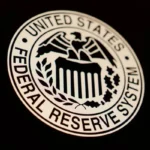
Stocks on Wall Street surged significantly higher on Friday leaving a trail of bears in their wake The rally followed the government’s report indicating a much-needed slowdown in hiring last month. For investors, this development signalled potential progress in the Federal Reserve’s efforts to combat inflation by applying high-interest rates to moderate economic growth.The S&P 500 surged by 1.3% on Friday, marking its most significant gain since February. Similarly, the Dow Jones Industrial Average climbed by 1.2%, while the Nasdaq composite soared by 2%. The report revealed that U.S. employers added 175,000 jobs in April, a notable decline from the substantial increase recorded in March.Notably, on the microstructure level Apple’s shares experienced a significant jump following the announcement of a massive $110 billion stock buyback this week.Friday’s weaker-than-expected employment report for April underscores the ongoing rebalancing in the labour market. Payroll growth decelerated significantly to a more manageable 175,000 jobs from the previous month’s robust 315,000. The unemployment rate edged up to 3.9%, marking a half-percentage-point increase from its expansion low. Additionally, the yearly growth in average hourly earnings dipped below 4.0% for the first time since June 2021, a most welcome sign for the Fed and keeping 3 rate cut hopes alive where we think a non-consensus cut for July could happen THE ECONOMIC BACKDROPIn March, the JOLTS data revealed a larger-than-expected decline in job openings to 8.5 million, the lowest level in over three years. This was accompanied by further decreases in new hires, separations, and quits, indicating a slowdown in labour demand and a growing reluctance among employees to seek new opportunities. The ratio of job openings to unemployed individuals peaked at a record high of 2.0 jobs per unemployed in March 2022 but has since declined to just 1.3 jobs in March. This ratio has reverted to pre-pandemic levels, suggesting a significant easing in labour shortages and the perceived overheating of the job market over the past two years.Equally important is the observable rebalancing of supply and demand, reflected in a growing array of economic indicators. Bloomberg’s U.S. economic surprise index has been slightly negative for over a month, indicating that indicators are generally falling short of analyst forecasts to a degree reminiscent of the first half of 2023 when GDP growth was hovering around a more subdued 2.0% annualized pace.
The ratio of job openings to unemployed individuals peaked at a record high of 2.0 jobs per unemployed in March 2022 but has since declined to just 1.3 jobs in March. This ratio has reverted to pre-pandemic levels, suggesting a significant easing in labour shortages and the perceived overheating of the job market over the past two years.Equally important is the observable rebalancing of supply and demand, reflected in a growing array of economic indicators. Bloomberg’s U.S. economic surprise index has been slightly negative for over a month, indicating that indicators are generally falling short of analyst forecasts to a degree reminiscent of the first half of 2023 when GDP growth was hovering around a more subdued 2.0% annualized pace. Most of the recent economic indicator misses seem to be concentrated in softer business and consumer surveys, while indicators related to housing, industrial activity, the labour market, and retail have shown relative resilience. For example, the ISM Manufacturing PMI for April fell back into contraction territory this week, where it has remained for most of the last two years. Similarly, the Services PMI dropped below 50 for the first time in 16 months.Meanwhile, the Conference Board’s Consumer Confidence Index experienced a significant decline last month, driven by deteriorating consumer perceptions of the labour market, income growth, and the overall economic outlook. Of particular concern is the sharp drop in confidence regarding the labour market, as reflected in the decline of the differential between consumers expecting more jobs versus fewer jobs six months from now to a level of minus 7.9, the lowest in over a decade.
Most of the recent economic indicator misses seem to be concentrated in softer business and consumer surveys, while indicators related to housing, industrial activity, the labour market, and retail have shown relative resilience. For example, the ISM Manufacturing PMI for April fell back into contraction territory this week, where it has remained for most of the last two years. Similarly, the Services PMI dropped below 50 for the first time in 16 months.Meanwhile, the Conference Board’s Consumer Confidence Index experienced a significant decline last month, driven by deteriorating consumer perceptions of the labour market, income growth, and the overall economic outlook. Of particular concern is the sharp drop in confidence regarding the labour market, as reflected in the decline of the differential between consumers expecting more jobs versus fewer jobs six months from now to a level of minus 7.9, the lowest in over a decade. While the current resilience of the harder economic data is notable, prolonged deterioration in survey-based data often precedes weakness in “hard” data over time, suggesting that caution may be warranted despite the current resilience.In essence, the accumulating signs of labour market rebalancing, coupled with the softening of consumer and business surveys, signal a forthcoming slowdown in consumer and business spending growth in the coming months.This slowdown is likely to hinder businesses’ ability to sustain the pace of price increases witnessed earlier this year, thereby putting pressure on their profits. This scenario may not bode well for stocks, especially if U.S. job numbers continue to decline, given that consumers have been pivotal in driving stronger U.S. earnings.While the direct link to consumer inflation is not immediate or definitive, considering the potential for additional global supply chain disruptions and energy shocks, the promising rebalancing trends seen in recent data still suggest a possible path for Fed rate cuts sometime this year, even if postponed until September. FOREX MARKETSThe recent easing in Treasury yields has tempered the strength of the dollar. While there remains a standoff between CTA’s and Japanese authorities regarding official yen support, I anticipate the market will respond more strongly to US economic data.Following two interventions by the Bank of Japan last week to support the yen, which had weakened to a 34-year low at 160 per dollar, and a weaker-than-expected Non-Farm Payrolls report, USDJPY retreated to three-week lows to 152 on Friday.However, USDJPY bounced back to 153 after Japan’s Finance Minister Suzuki hinted at potential measures to address excessive FX moves, possibly aiming to achieve stability at current levels.With US Consumer Price Index (CPI) and Producer Price Index (PPI) data scheduled for release next week, volatility should persist in the forex market, particularly in USDJPY.Regarding USDJPY trading, our approach is day by day, especially after Finance Minister Suzuki’s comments took some of the heat out of the long USDJPY squeeze. We might be entering a broader consolidation phase, with levels between 152 and 155 indicating that intervention was more successful than expected. However, we could also revert to the TONA vs SOFR differential dynamic, potentially driving USDJPY higher. Essentially, we could be entering a phase of price discovery rather than directional certainty next week.The extent to which the NPF headline miss might fuel concerns about a recession, for the time being, 175,000 represents a fundamentally robust pace of hiring. Any significant downward revisions next month alongside another substantial miss may warrant cause for concern.Overall I’m more convinced we are in the later innings of this cycle of dollar strength and may look to add to dollar shorts on any dollar strength more so versus the EURO OIL MARKETSThis week saw a decline in oil prices, driven by a perceived reduction in immediate geopolitical risks and indications of a demand slowdown in the US. The geopolitical tension that had previously bolstered crude prices diminished, coinciding with macroeconomic data signalling a slowdown in the US economy during April, which dampened fuel demand.Losses in RBOB futures accelerated following an unexpected contraction in the US service sector reported by the Institute of Supply Management (ISM) on Friday. This, coupled with a weaker US dollar resulting from an unexpected rise in the national unemployment rate and lower-than-expected job growth of 175,000, intensified pressure on gasoline futures. Earlier in the week, souring consumer confidence, as reported by The Conference Board, also contributed to downward pressure on the gasoline contract. Consumers expressed intentions to reduce discretionary spending, including on dining out and vacations.Stagnation in industrial production and the knock-on effect it has on freight hauling has thwarted consumption and marked a more pronounced bearish skew in diesel markets which has also fed into the benchmarks. WEEK IN REVIEWAfter closing off the month of April in the red, equities rebounded in the latter part of the week, finding support from positive earnings reports, notably from Apple, a Federal Reserve that was less hawkish than anticipated, and some upbeat late-week data. Among major indices, the tech-heavy NASDAQ saw the most substantial gains, climbing by 1.4% for the week, closely followed by the Dow, which rose by 1.1%.The FOMC announcement on Wednesday took center stage, with no changes to rates as anticipated. However, the monthly pace of quantitative tightening was reduced from $60 billion to $25 billion starting June 1st. While the press statement acknowledged “a lack of further progress” towards the inflation target, Chair Powell later indicated that further rate hikes are “unlikely” in this cycle. Overall, the Fed’s stance was less hawkish than expected given current inflation trends, which was a relief for markets. It seems the FOMC is comfortable staying on hold for the foreseeable future.Friday’s softer-than-expected payrolls report further buoyed sentiment. Payrolls increased by a modest 175k in April, with the jobless rate ticking up to 3.9%. Notably, wage growth slowed more than anticipated, with the yearly change in average hourly earnings cooling to 3.9%, its slowest pace in almost three years.However, there were still some inflationary signals during the week, including an increase in employment costs for Q1, rising home prices in February, and a notable uptick in the manufacturing ISM’s prices paid index for April—the most significant rise since June 2022. This was attributed to the recent surge in resource prices, signalling potential upside risks to goods inflation. Given these factors, the Fed’s decision to maintain its current stance is prudent, still the market will take comfort from the NFP data and Chair Powell who is looking for any reason to cut rates. CHARTS OF THE WEEKConfidence retreated further in April, reaching its lowest level since July 2022 as consumers became less positive about the current labour market situation and more concerned about future business conditions, job availability, and income.
While the current resilience of the harder economic data is notable, prolonged deterioration in survey-based data often precedes weakness in “hard” data over time, suggesting that caution may be warranted despite the current resilience.In essence, the accumulating signs of labour market rebalancing, coupled with the softening of consumer and business surveys, signal a forthcoming slowdown in consumer and business spending growth in the coming months.This slowdown is likely to hinder businesses’ ability to sustain the pace of price increases witnessed earlier this year, thereby putting pressure on their profits. This scenario may not bode well for stocks, especially if U.S. job numbers continue to decline, given that consumers have been pivotal in driving stronger U.S. earnings.While the direct link to consumer inflation is not immediate or definitive, considering the potential for additional global supply chain disruptions and energy shocks, the promising rebalancing trends seen in recent data still suggest a possible path for Fed rate cuts sometime this year, even if postponed until September. FOREX MARKETSThe recent easing in Treasury yields has tempered the strength of the dollar. While there remains a standoff between CTA’s and Japanese authorities regarding official yen support, I anticipate the market will respond more strongly to US economic data.Following two interventions by the Bank of Japan last week to support the yen, which had weakened to a 34-year low at 160 per dollar, and a weaker-than-expected Non-Farm Payrolls report, USDJPY retreated to three-week lows to 152 on Friday.However, USDJPY bounced back to 153 after Japan’s Finance Minister Suzuki hinted at potential measures to address excessive FX moves, possibly aiming to achieve stability at current levels.With US Consumer Price Index (CPI) and Producer Price Index (PPI) data scheduled for release next week, volatility should persist in the forex market, particularly in USDJPY.Regarding USDJPY trading, our approach is day by day, especially after Finance Minister Suzuki’s comments took some of the heat out of the long USDJPY squeeze. We might be entering a broader consolidation phase, with levels between 152 and 155 indicating that intervention was more successful than expected. However, we could also revert to the TONA vs SOFR differential dynamic, potentially driving USDJPY higher. Essentially, we could be entering a phase of price discovery rather than directional certainty next week.The extent to which the NPF headline miss might fuel concerns about a recession, for the time being, 175,000 represents a fundamentally robust pace of hiring. Any significant downward revisions next month alongside another substantial miss may warrant cause for concern.Overall I’m more convinced we are in the later innings of this cycle of dollar strength and may look to add to dollar shorts on any dollar strength more so versus the EURO OIL MARKETSThis week saw a decline in oil prices, driven by a perceived reduction in immediate geopolitical risks and indications of a demand slowdown in the US. The geopolitical tension that had previously bolstered crude prices diminished, coinciding with macroeconomic data signalling a slowdown in the US economy during April, which dampened fuel demand.Losses in RBOB futures accelerated following an unexpected contraction in the US service sector reported by the Institute of Supply Management (ISM) on Friday. This, coupled with a weaker US dollar resulting from an unexpected rise in the national unemployment rate and lower-than-expected job growth of 175,000, intensified pressure on gasoline futures. Earlier in the week, souring consumer confidence, as reported by The Conference Board, also contributed to downward pressure on the gasoline contract. Consumers expressed intentions to reduce discretionary spending, including on dining out and vacations.Stagnation in industrial production and the knock-on effect it has on freight hauling has thwarted consumption and marked a more pronounced bearish skew in diesel markets which has also fed into the benchmarks. WEEK IN REVIEWAfter closing off the month of April in the red, equities rebounded in the latter part of the week, finding support from positive earnings reports, notably from Apple, a Federal Reserve that was less hawkish than anticipated, and some upbeat late-week data. Among major indices, the tech-heavy NASDAQ saw the most substantial gains, climbing by 1.4% for the week, closely followed by the Dow, which rose by 1.1%.The FOMC announcement on Wednesday took center stage, with no changes to rates as anticipated. However, the monthly pace of quantitative tightening was reduced from $60 billion to $25 billion starting June 1st. While the press statement acknowledged “a lack of further progress” towards the inflation target, Chair Powell later indicated that further rate hikes are “unlikely” in this cycle. Overall, the Fed’s stance was less hawkish than expected given current inflation trends, which was a relief for markets. It seems the FOMC is comfortable staying on hold for the foreseeable future.Friday’s softer-than-expected payrolls report further buoyed sentiment. Payrolls increased by a modest 175k in April, with the jobless rate ticking up to 3.9%. Notably, wage growth slowed more than anticipated, with the yearly change in average hourly earnings cooling to 3.9%, its slowest pace in almost three years.However, there were still some inflationary signals during the week, including an increase in employment costs for Q1, rising home prices in February, and a notable uptick in the manufacturing ISM’s prices paid index for April—the most significant rise since June 2022. This was attributed to the recent surge in resource prices, signalling potential upside risks to goods inflation. Given these factors, the Fed’s decision to maintain its current stance is prudent, still the market will take comfort from the NFP data and Chair Powell who is looking for any reason to cut rates. CHARTS OF THE WEEKConfidence retreated further in April, reaching its lowest level since July 2022 as consumers became less positive about the current labour market situation and more concerned about future business conditions, job availability, and income. China exports more than ever to the world, but it doesn’t want to put the Dollars it earns into Treasuries, since that will only deepen its dependence on the US. So China builds inventories in Dollar-denominated commodities. Imports of basic metals are up 60% from before COVID
China exports more than ever to the world, but it doesn’t want to put the Dollars it earns into Treasuries, since that will only deepen its dependence on the US. So China builds inventories in Dollar-denominated commodities. Imports of basic metals are up 60% from before COVID More By This Author:Is The NFP Cat Out Of The Bag?
More By This Author:Is The NFP Cat Out Of The Bag?
NFP: The Ultimate Litmus Test For Doves Vs. Hawks And A Central Bank Intervention Masterclass
Asia Open: The FOMC Whipsaw And More Yen Intervention In Focus














